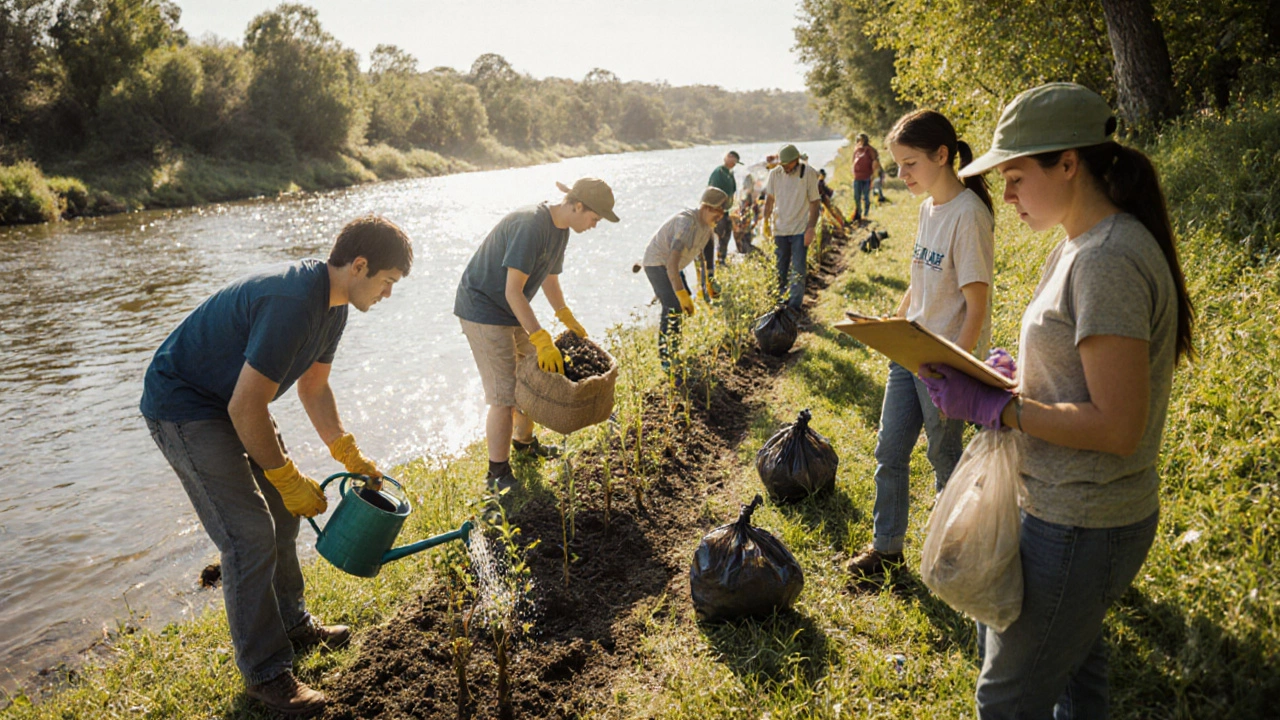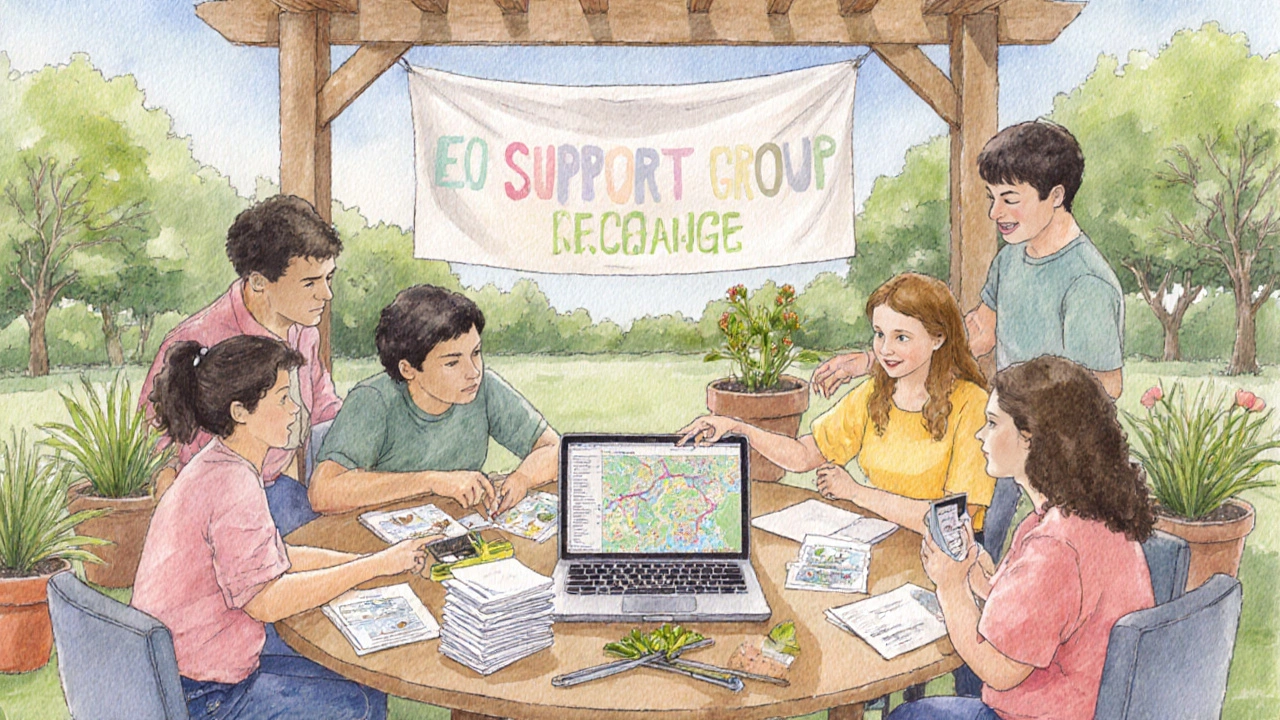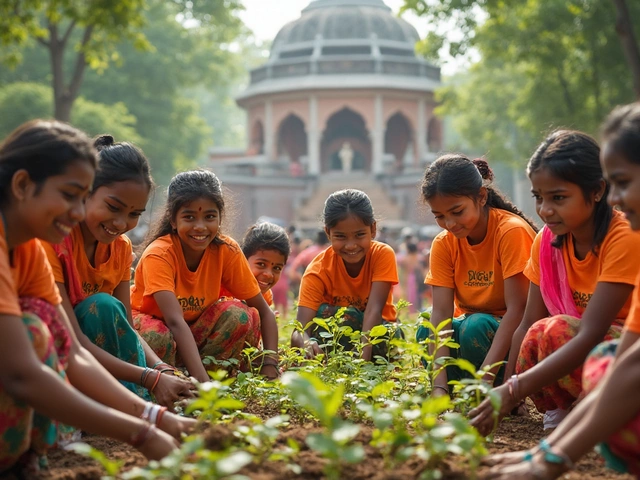Environmental Impact Calculator
Measure Your Group's Environmental Impact
Calculate carbon offsets from tree planting and litter removal to share your group's achievements.
Project Inputs
Results
Your group's work has made a meaningful impact!
Share these results with your community to build momentum.
When you hear the term environment support group, you might wonder if it’s another name for an eco‑club or a charity. In reality, an environment support group is a community‑focused network that blends peer support with hands‑on environmental action. It gives people a safe space to share concerns about climate anxiety, eco‑grief, or sustainability challenges while also organizing projects like tree planting, clean‑ups, and advocacy campaigns.
Defining the Core Concept
Environment Support Group is a localized, non‑profit or volunteer‑driven collective that offers emotional, educational, and practical support around environmental issues. Unlike a traditional support group that focuses solely on personal well‑being, an environment support group tackles both mental health and tangible ecological outcomes. Members meet regularly-usually in person or via video chat-to discuss climate‑related stress, exchange resources, and plan community projects.
Why These Groups Matter
Climate change isn’t just a scientific problem; it’s a social one. People report feelings of helplessness, anxiety, and grief as they witness worsening weather events and species loss. An environment support group provides a structured outlet for these emotions, turning worry into action. The benefits stack up:
- Emotional relief: Sharing experiences normalizes feelings and reduces isolation.
- Skill building: Workshops teach composting, native planting, or how to talk to local councils.
- Community impact: Group projects create measurable environmental gains-e.g., removing 2tonnes of litter from a local river.
- Advocacy power: A united voice can influence municipal policies on waste, transport, or green space.
Typical Activities and Programs
While each group tailors its agenda, most include a mix of the following:
- Peer‑Sharing Sessions - Casual meetings where members discuss news, personal challenges, and coping strategies.
- Educational Workshops - Hands‑on learning about topics like renewable energy, sustainable gardening, or carbon budgeting.
- Community Action Days - Organized clean‑ups, tree‑planting drives, or habitat restoration events.
- Advocacy Campaigns - Letter‑writing, petitions, or public meetings aimed at local government.
- Resource Exchanges - Tool libraries, seed swaps, or bulk‑buy discounts for eco‑friendly products.

How to Join an Existing Group
Finding a local environment support group is easier than you think. Here’s a quick checklist:
- Search social platforms (Facebook, Meetup) for keywords like “environment support group” plus your city.
- Visit community centres or libraries - they often host bulletin boards with group flyers.
- Contact local Environmental NGOs - many run satellite support circles for volunteers.
- Check with local government environmental departments - they sometimes fund peer‑support initiatives.
When you reach out, ask about meeting frequency, membership expectations (often free or low‑cost), and whether they provide mental‑health resources or referral pathways.
Starting Your Own Group: A Step‑by‑Step Guide
If you can’t find a suitable circle, consider launching one. Follow these eight steps to get off the ground:
- Clarify the purpose. Write a one‑sentence mission, e.g., “To connect Auckland residents coping with climate anxiety through shared action.”
- Identify a host venue. Libraries, churches, or coworking spaces often let community groups meet for free.
- Recruit core members. Invite friends, neighbours, or contacts from existing community outreach programs.
- Set a regular schedule. Weekly or bi‑weekly meetings keep momentum without overwhelming volunteers.
- Create a simple charter. Outline confidentiality rules, decision‑making process, and any costs for supplies.
- Plan an opening workshop. Offer a beginner‑friendly session on “Understanding Climate Grief” led by a mental‑health professional.
- Promote. Use flyers, local newspaper notices, and social media hashtags (#EcoSupportAuckland).
- Evaluate and adapt. After three months, survey members on what’s working and adjust format accordingly.
Remember, you don’t need a formal charity status to start; a simple bank account for shared funds often suffices.
Comparing Different Types of Environmental Support Structures
| Aspect | Environment Support Group | Traditional Support Group | Environmental NGO |
|---|---|---|---|
| Primary Focus | Climate‑related emotional wellbeing + local action | Personal mental‑health issues (non‑environmental) | Broad environmental advocacy and program delivery |
| Membership Cost | Usually free or minimal | Often free; some may charge for professional facilitation | May require membership fees or donations |
| Typical Activities | Discussion circles, clean‑ups, workshops | Peer sharing, guided therapy | Research, policy lobbying, large‑scale projects |
| Decision‑Making | Consensus or informal voting | Facilitator‑led or peer‑led | Board of directors, formal governance |
| Legal Structure | Often informal, can register as a charity later | Informal or tied to a health service | Registered non‑profit or charitable trust |

Common Challenges and How to Overcome Them
Running an environment support group isn’t always smooth sailing. Here are the three most frequent hurdles and practical fixes:
- Member burnout: Rotate facilitation duties, schedule occasional “no‑action” socials, and encourage self‑care check‑ins.
- Funding shortfalls: Apply for micro‑grants from local councils, host a community fundraiser, or partner with a nearby garden centre for in‑kind donations.
- Low participation in action days: Co‑create project ideas with members, set clear, achievable goals (e.g., collect 50kg of trash), and celebrate successes publicly.
Resources for Ongoing Learning
Staying informed empowers both the group and its members. Consider these reputable sources:
- Intergovernmental Panel on Climate Change (IPCC) reports - provide scientific grounding for discussions.
- Climate‑Psychology Alliance - offers toolkits for mental‑health practitioners working with eco‑anxiety.
- Local council sustainability portals - list permits, recycling programs, and grant opportunities.
- Community Tool Library networks - can supply gardening tools or protective equipment for field work.
Next Steps for Readers
Whether you’re looking to join a group, start one, or simply learn more, pick one concrete action today:
- Search “environment support group” plus your town on Facebook and RSVP to the next meeting you find.
- Gather three friends, draft a one‑sentence mission, and book a free meeting room for next Thursday.
- Download the latest IPCC summary for non‑technical audiences and share a key takeaway in your next conversation.
Small steps add up, and every supportive conversation or clean‑up knot drives the larger wave of climate resilience.
Frequently Asked Questions
Do I need a background in environmental science to join?
No. These groups welcome anyone who cares about the environment, regardless of expertise. Many sessions are designed for beginners.
Are the meetings confidential?
Most groups adopt a confidentiality rule similar to traditional peer‑support circles: what’s shared stays within the group, unless a member threatens harm.
Can I attend if I’m not a resident of the area?
Many groups now hold virtual meetings, so geographic limits are less of a barrier. Check the group’s format before signing up.
What are typical costs for members?
Most groups are free. Occasionally there are small fees for materials (e.g., seed packets) or venue rentals, but these are usually covered by voluntary donations.
How can I measure the impact of our projects?
Track simple metrics: number of participants, kilograms of litter removed, trees planted, or carbon‑offset estimates from a planting calculator. Share results in your next meeting to keep motivation high.






